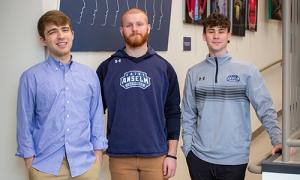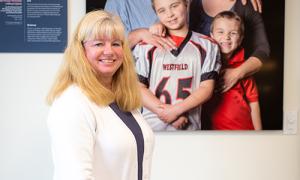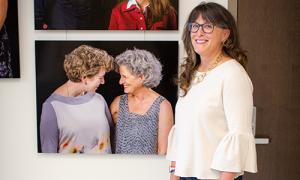Moving out of a pandemic and into a post-pandemic world, where uncertainty is often the only constant, a group of dedicated students and their advisor help peers recognize, navigate, and discuss the many layers of mental health.

When Kris Wilson L.I.C.S.W., A.C.S.W., a clinical social worker and counselor in the Saint Anselm College health services office, first heard about the traveling art exhibit, The 99 Faces of Mental Health, being installed at nearby Concord High School in Concord, N.H., she had an idea. A good one. The kind that keeps you up at night with excitement, and the kind that gives you no choice but to act. The idea: Bring the exhibit to Saint Anselm College.
The exhibit, created by artist Lynda Michaud Cutrell, is a compilation of portraits and 3-D sculptures, showcasing 99 people—33 of whom have bipolar disorder, 33 with schizophrenia, and 33 loved ones. The added layer to this powerful exhibit is that the portraits of those struggling with mental health are not labeled, demonstrating it could be any one of the 99 people who are struggling.
“This exhibit personifies our collaborative mission to lessen stigma surrounding mental health struggles, open up conversations around resources and offer hope for those that struggle and their loved ones here in our community,” says Wilson.
Wilson knew bringing the exhibit to campus would be an undertaking, but she also knew whom to turn to for help—a group of talented and driven student leaders she had been working with to help support mental health awareness on campus, Chris DeMarkey ’23, Meghan Gibbons ’23, CJ Hart ’22, and Jordan Trombly ’22.
“It never dawned on me not to look to these particular students for help—I knew they could take this on, and I don’t know where the project would have gone without them,” says Wilson.
Each of the students, who are open about their personal struggles with mental health, also represented three newly formed mental health-related organizations on campus—Active Minds, a national nonprofit focusing on action and student advocacy in mental health; The Head Game Project, a student-run organization intent on establishing a culture of openness and support for student-athletes struggling with mental health issues; and the Mental Health Committee, a subcommittee formed out of the Student Government Association designed to help students struggling with mental health.
“None of us really knew each other very well before coming together for this project,” says Hart, who, in addition to being the goalie for the men’s lacrosse team, leads the Head Game Project, which he co-founded with Ally Irish ’21 last year. “But the more I learned about the exhibit, the more impressed I became—it was clear we were all connected to the same mission, and we were coming together with one goal in mind.”
For Trombly, who is a member of the men’s soccer team and president of the college’s chapter of Active Minds, bringing the exhibit to campus was an easy decision. “When Kris told us about this exhibit on display and asked what we thought about bringing it to campus, we immediately drove to Concord to take a tour,” he says. “Once we saw it, we knew we had to bring it here.”
And so began several months of meetings and planning. “The entire process was a bit surreal in how quickly it moved and how much was involved,” says DeMarkey, who, along with Gibbons, is co-chair of the Mental Health Committee. “We went from seeing the exhibit and meeting the artist to then physically setting up the exhibit—not to mention the countless hours of logistics involved in coordinating people, the phone calls, the meetings … it took several months to make it happen.”
A severe snowstorm almost interfered with the exhibit’s debut on campus in January, but the group handled the obstacle without missing a beat. “These students had to come back early from Christmas break to help set this up, and we had this severe storm,” says Wilson. “Chris couldn’t even make it up the driveway, so he parked his car on the road and walked the rest of the way, with no complaint.”
Working for nearly five months to bring the exhibit from idea to implementation was an immense undertaking but also imperative, according to Gibbons. “Mental health is a topic of conversation that shouldn’t be hidden,” she says. “This exhibit lets others learn more about the stories of those who struggle with mental health.”
Gibbons, who also is a member of the women’s softball team, has seen a tremendous shift in people’s willingness to talk about mental health. “When I was a first-year student, mental health wasn’t something that was talked about,” she says. “But with Covid, the conversation has changed—people opened their eyes to the fact that this was a conversation we needed to have, it’s been such a positive change.”
Stopping the Stigma

While Gibbons remembers a time when the subject of mental health was not always openly discussed, the arrival of the Covid-19 pandemic has brought the topic to the forefront, especially for college-age students. According to Active Minds, 39 percent of students in college experience a significant mental health issue, and data recently published in The Boston Globe from the Centers for Disease Control and Prevention, which was collected on a rolling basis throughout the pandemic, shows people between the ages of 18 and 29 reporting the highest rates of anxiety and depression of any age group.
“We are definitely seeing that students are in a constant state of worrying,” says Maura Marshall, A.P.R.N., M.S.N., director of health services. “Due to social media constantly bombarding us with information, some people start each day in a fight-or-flight mode.”
The pandemic, according to Marshall, also created a delay in social and emotional development among many students. “It really hit me this fall when I had a first-year student come to me—she hadn’t left her house since March of 2020, and now her first time out of the house was for one of life’s most major transitions, coming to a college campus to live,” says Marshall. “This transition is hard under normal circumstances, but add to this the pandemic, and we’re talking real struggle for many.”
Since Marshall arrived at the college in 2009, she has seen the total number of visits to her office almost double from 840 during 2009-2010 school year to 1,530 total visits for the 2020-2021 school year. To meet the increase, Marshall and her team have expanded their counseling hours, collaborated with community resources, and offered the option of telehealth. They also have assigned a counselor to each of the varsity sports teams.
"We are definitely seeing that students are in a constant state of worrying."
- Maura Marshall, A.P.R.N., M.S.N., Director of Health Services
“We have four counselors [two men, two women] available Monday to Friday from 9 to 5,” she says. “We have on-call counselors who are available 24/7 and can be reached after hours by dialing 603-641-7000. We also have a nurse practitioner who works directly with the counselors and is able to prescribe medication when needed.”
In addition, Marshall explains their counselors work with groups on campus for mindfulness workshops, test anxiety, and advise the three student mental health groups. “We worked with NAMI [National Alliance for Mental Illness] to provide suicide prevention training, with NASPA (National Association of Student Personnel Administrators) for peer education training, and a mental health training module for all student leaders on campus,” she says.
The college also recently approved a teletherapy app platform, known as Uwill, to supplement counseling support in health services. The app will offer a diverse pool of therapists available for students after hours and on weekends that they can access privately, right from their phone. “Whenever I speak to other schools and our community resources, they are so impressed by the level of care and crisis management that we provide at Saint A’s,” says Marshall.
This important work, along with the work of the three student mental health groups on campus, are helping to significantly reduce the stigma associated with mental health.
“Society is more open to discussing mental health issues,” says Marshall. “Students and families are sometimes basing their decision about college based on the mental health support on campus.”
"It really demonstrates how taking care of your mental health is essentially just like entering another training room."
- CJ Hart '22, Co-Founder, The Head Game Project
Building Awareness, Finding Community

On opening night of The 99 Faces Project on campus in January, the support for mental health awareness on campus was evident. “I was a little surprised by the crowd on opening night,” says Trombly. “And it wasn’t just students, there were staff, faculty, and family members—everyone was so interested and engaged.”
The number of tour requests and general traffic also was a pleasant surprise for DeMarkey. Before the exhibit concluded in late April, more than 1,300 people had toured the exhibit. “We gave a tour to several members of the college’s board of trustees, and it was so gratifying to hear they were talking about the exhibit for days,” he says. “It was also so satisfying to overhear students comment on what they learned about the science behind mental illness.”
For Hart, the overwhelming support from fellow athletes was especially meaningful. “On opening night, I arrived straight from practice, and when I saw the crowd, I was blown away by how many people, especially athletes, made time for this,” he says. “It really demonstrates how taking care of your mental health is essentially just like entering another training room,” he says. “We make time to take care of our physical fitness, and our physical injuries, and people are beginning to see taking care of your mental health is just as important.”
The outpouring of interest and support in the exhibit during its time on campus has been proof that Wilson’s idea to bring the exhibit to campus was indeed a good one. The genuine interest in openly discussing mental health has been beyond meaningful for Wilson but so too has watching this group of student leaders work together for the greater good. “The willingness of these students to show up and work hard for the peers during their free time is the finest example of service to others that I’ve had the blessing to witness,” she says.
Equally gratifying for Wilson, and all the student leaders, is the impact the exhibit has had on the Saint Anselm community. “It’s been overwhelming to see visitors entering the exhibit with an open mind, and be willing to talk about it,” says Trombly. “There’s this stigma that you’re weak, or less of a person if you suffer from mental illness, but really, it shows the greatest strength possible if you’re willing to talk about it, and this exhibit, I think, has helped people do that.”
"We want everyone who may be struggling with mental illness to know there's so much more to you than this, but most importantly, you're not alone."
- Kris Wilson, L.I.C.S.W., A.C.S.W, Clinical Social Worker and Counselor
For DeMarkey, seeing visitors leave with a better understanding that mental illness affects everyone has been meaningful. “Mental illness can happen to anyone, it doesn’t discriminate, it doesn’t matter who you are or where you’re from,” he says. “But also, we hope people walk away knowing they are not in this alone, we care about you, and everyone on campus wants you to succeed.”
Wilson couldn’t agree more. “This exhibit has had a very powerful impact, and my hope is we can continue this momentum,” she says. “This has been an important step in how to normalize mental illness, and that mental health is just one piece of our whole selves—we want everyone who may be struggling with mental illness to know there’s so much more to you than this, but most importantly, you’re not alone.”
Thank you to Lynda Michaud Cutrell, artist of the 99 Faces Project.
The Healing Power of Art, and Community
The student art below was created during a paint night hosted by the Residential Learning Community's Creative Corner group.

On a Monday night in April, more than 50 students gathered in the courtyard outside of Saint Benedict Court. Supplied with paint, paint brushes, and plenty of canvas, the purpose was not only to create something beautiful—it was about coming together, reducing anxiety, and healing through art.
This paint night was just one event of many hosted by the Creative Corner, a group of five students who are part of the college’s Residential Learning Community (RLC). “The RLC is a way for students to expand their learning out of the classroom and into their living space,” says Mackenzie Kewley, M.S.W. ’19, resident director of Father Bernard Courts and Holy Cross Hall. “RLC groups can be formed out of a connection to a certain major, or a common interest, and the goal is to teach your peers about something you’re passionate about—it makes the dorms a place where you not only live but are able to expand your horizons in different ways beyond the classroom.”
The Creative Corner, which just finished its third year as part of RLC, formed to help peers use art and creativity to help de-stress and promote beauty, both within each other and the overall community. “This group has really pushed themselves to understand what their peers might want or need to help de-stress, and paint night came out of this,” says Kewley. “It highlighted for students the importance of taking that break from a busy routine, creating art, listening to music, coming together, and this helps mental health.”
In addition to the Creative Corner group, other RLC groups focusing on mental health include Find My Fitness and Don’t Stress, Worry Less. “Find My Fitness’ goal is to learn how to incorporate healthy habits in relation to wellness that the SAC community can take with them when they graduate,” says Kewley. “They are focusing on helping find ways through fitness to improve one’s physical well-being, mental well-being, spirituality, and nutrition in a holistic way. They want students to know that wellness is not linear and can be different for everyone.”
Don’t Stress, Worry Less encourages healthy and positive coping techniques to help relieve the anxieties and pressures students face daily. “They wanted their programming to be guided by the Benedictine values and to specifically cater to the unique needs within the community,” she says.
New for next year, Preparation Nation—a program designed to help students handle the stressors of life after college, including managing finances, working in an office that may be remote or partially remote, and how to navigate that socially and professionally.
“These RLC groups help students share what they are passionate about, and allow for students to connect with each other, and the community,” says Kewley. “And with events like paint night, it’s not just about painting, it’s about connecting, and being aware of how and why something like this is helping reduce anxiety and stress.” —K.G.D.
